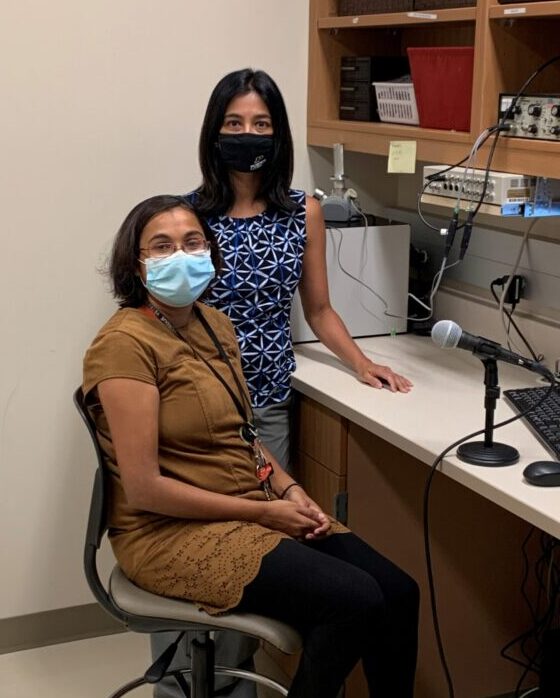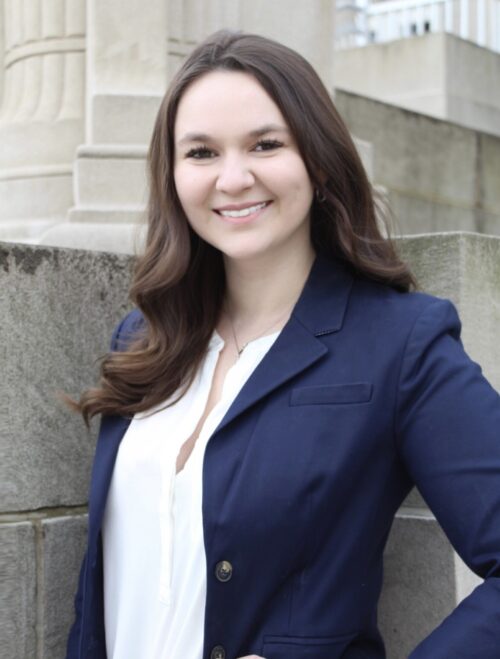Purdue researchers aim to help fitness instructors keep their voices in shape
Written By: Rebecca Hoffa, rhoffa@purdue.edu

Anumitha Venkatraman (left), voice pathologist and doctoral student, and Preeti Sivasankar (right), professor and head of the Department of Speech, Language, and Hearing Sciences, investigated the factors that contribute to voice problems in fitness instructors in their new review paper.Photo provided
For Ellie Kielb, a typical Friday consists of getting up early to teach a high intensity interval training class at VASA Fitness in Lafayette before she comes to Purdue University’s campus as a doctoral student in the Department of Human Development and Family Studies. When she wraps up her work, she ends the day teaching yoga. These are just two of the four group fitness classes Kielb instructs each week. While her love of fitness and teaching create the perfect combination for leading group fitness, being a fitness instructor hasn’t always been easy.
“When you’re teaching fitness classes, someone in the back of the class is probably 20 or 25 feet away, and those first few weeks, working out and talking at the same time, I felt like I had to exert my voice significantly more,” Kielb said. “I definitely lost my voice several times.”
As part of her research in the College of Health and Human Sciences, Anumitha Venkatraman, voice pathologist and doctoral student in the Department of Speech, Language, and Hearing Sciences (SLHS), discovered that voice problems are a significant concern for fitness instructors.
She examined five factors that contribute to voice problems for this group: cognitive load, or how the mind functions while doing two tasks simultaneously; dehydration; phonation, or how the voice works; the metabolic demands of exercising and using the voice concurrently; and the psychosocial stress of speaking and exercising in front of a large group.
“The voice literature doesn’t really study these particular factors and how they affect voice in the fitness instructor population,” Venkatraman explained.
When approaching the study, which was published in the Journal of Voice, Venkatraman and her co-authors, SLHS professor and department head Preeti Sivasankar and former PhD student Robert Fujiki, looked at the literature that was specific to the five factors they were investigating for the general population. Then, they used that to inform how these factors affect fitness instructors specifically.
Because there is limited published data on fitness instructors, more research needs to be done to offer clinical recommendations that are tailored to fitness instructors. Additionally, because the patients who typically come to the SLHS clinics are experiencing a chronic voice problem, where their voice has stayed altered for a while, it can be difficult to know what the long-term consequences are for fitness instructors whose voices may go in cycles of getting worse and improving.
“One thing we realized is how interdisciplinary this work is and how we need to work with Nutrition Science, Health and Kinesiology, and Health Sciences as we understand the connection of voice, metabolism, what we intake and how exercise affects the voice,” Sivasankar said.
When looking at possible solutions for reducing voice problems in fitness instructors, Venkatraman said microphones were a promising takeaway from the study because they allow fitness instructors to speak at a lower volume. This reduces the strain that a single class can have on their voice and throat muscles.

Ellie Kielb, doctoral student and fitness instructor at VASA FitnessPhoto provided
Kielb did not have a microphone when she was instructing a for-credit group fitness class at Purdue, and she noticed she lost her voice much more often. In retrospect, she said she was sure the University would have gotten her a microphone if she asked, but it just wasn’t something that crossed her mind. However, since having a microphone at VASA Fitness, she has noticed fewer voice problems.
“I will say when I switched from not having a microphone to having a microphone, I noticed a much bigger change,” Kielb said. “I don’t have to use a microphone — they’re not required — but they try really hard to make it available to us.”
In many cases, awareness of voice problems can offer some protection by allowing fitness instructors to get the support they need to keep their voice in shape, Venkatraman noted.
“If fitness instructors aren’t really aware that they could develop a voice problem, and then they have classes back-to-back, and they don’t realize how much damage they’re doing to their voice, it might be hard for them to maintain their voice as they keep doing this long-term,” Venkatraman said.
Because fitness instructors rely on their voice as a function of their job — even though many instructors, like Kielb, only teach fitness classes part-time — when they experience voice problems, it can cause difficulties for both the instructors and those taking the classes.
“If you have a voice problem, and you can’t speak right now, that affects how you go about your daily living,” Venkatraman said. “For a fitness instructor, if they have to speak loudly, and they use their voice to not only motivate the people who come to their class but also make sure that everyone is getting their money’s worth, they’re using their voice as a part of their profession, so a voice problem imposes a financial burden.”
Support from the fitness studios is important to foster an environment that helps instructors keep their voice in shape, according to the researchers. For Kielb, her studio not only offers a great sound system but also fosters an environment where she can be flexible and take time to rest her voice if she needs it.
“That’s one of the things my boss is very responsive to,” Kielb said. “If my voice is gravelly or I can’t talk, she says it’s very important that I not only take care of myself but also that the people in the class can hear me.”